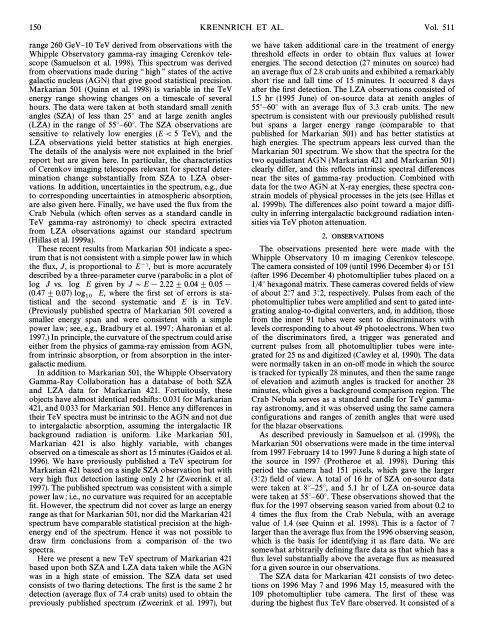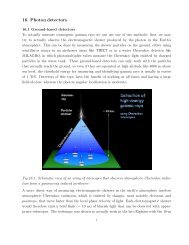Measurement of the Multi-TeV Gamma-Ray Flare Spectra of ...
Measurement of the Multi-TeV Gamma-Ray Flare Spectra of ...
Measurement of the Multi-TeV Gamma-Ray Flare Spectra of ...
You also want an ePaper? Increase the reach of your titles
YUMPU automatically turns print PDFs into web optimized ePapers that Google loves.
150 KRENNRICH ET AL. Vol. 511<br />
range 260 GeVÈ10 <strong>TeV</strong> derived from observations with <strong>the</strong><br />
Whipple Observatory gamma-ray imaging Cerenkov telescope<br />
(Samuelson et al. 1998). This spectrum was derived<br />
from observations made during ““ high ÏÏ states <strong>of</strong> <strong>the</strong> active<br />
galactic nucleus (AGN) that give good statistical precision.<br />
Markarian 501 (Quinn et al. 1998) is variable in <strong>the</strong> <strong>TeV</strong><br />
energy range showing changes on a timescale <strong>of</strong> several<br />
hours. The data were taken at both standard small zenith<br />
angles (SZA) <strong>of</strong> less than 25¡ and at large zenith angles<br />
(LZA) in <strong>the</strong> range <strong>of</strong> 55¡È60¡. The SZA observations are<br />
sensitive to relatively low energies (E \ 5 <strong>TeV</strong>), and <strong>the</strong><br />
LZA observations yield better statistics at high energies.<br />
The details <strong>of</strong> <strong>the</strong> analysis were not explained in <strong>the</strong> brief<br />
report but are given here. In particular, <strong>the</strong> characteristics<br />
<strong>of</strong> Cerenkov imaging telescopes relevant for spectral determination<br />
change substantially from SZA to LZA observations.<br />
In addition, uncertainties in <strong>the</strong> spectrum, e.g., due<br />
to corresponding uncertainties in atmospheric absorption,<br />
are also given here. Finally, we have used <strong>the</strong> Ñux from <strong>the</strong><br />
Crab Nebula (which <strong>of</strong>ten serves as a standard candle in<br />
<strong>TeV</strong> gamma-ray astronomy) to check spectra extracted<br />
from LZA observations against our standard spectrum<br />
(Hillas et al. 1999a).<br />
These recent results from Markarian 501 indicate a spectrum<br />
that is not consistent with a simple power law in which<br />
<strong>the</strong> Ñux, J, is proportional to E~c, but is more accurately<br />
described by a three-parameter curve (parabolic in a plot <strong>of</strong><br />
log J vs. log E given by J D E [ 2.22 ^ 0.04 ^ 0.05 [<br />
(0.47 ^ 0.07) log E, where <strong>the</strong> Ðrst set <strong>of</strong> errors is sta-<br />
10<br />
tistical and <strong>the</strong> second systematic and E is in <strong>TeV</strong>.<br />
(Previously published spectra <strong>of</strong> Markarian 501 covered a<br />
smaller energy span and were consistent with a simple<br />
power law; see, e.g., Bradbury et al. 1997; Aharonian et al.<br />
1997.) In principle, <strong>the</strong> curvature <strong>of</strong> <strong>the</strong> spectrum could arise<br />
ei<strong>the</strong>r from <strong>the</strong> physics <strong>of</strong> gamma-ray emission from AGN,<br />
from intrinsic absorption, or from absorption in <strong>the</strong> intergalactic<br />
medium.<br />
In addition to Markarian 501, <strong>the</strong> Whipple Observatory<br />
<strong>Gamma</strong>-<strong>Ray</strong> Collaboration has a database <strong>of</strong> both SZA<br />
and LZA data for Markarian 421. Fortuitously, <strong>the</strong>se<br />
objects have almost identical redshifts: 0.031 for Markarian<br />
421, and 0.033 for Markarian 501. Hence any di†erences in<br />
<strong>the</strong>ir <strong>TeV</strong> spectra must be intrinsic to <strong>the</strong> AGN and not due<br />
to intergalactic absorption, assuming <strong>the</strong> intergalactic IR<br />
background radiation is uniform. Like Markarian 501,<br />
Markarian 421 is also highly variable, with changes<br />
observed on a timescale as short as 15 minutes (Gaidos et al.<br />
1996). We have previously published a <strong>TeV</strong> spectrum for<br />
Markarian 421 based on a single SZA observation but with<br />
very high Ñux detection lasting only 2 hr (Zweerink et al.<br />
1997). The published spectrum was consistent with a simple<br />
power law; i.e., no curvature was required for an acceptable<br />
Ðt. However, <strong>the</strong> spectrum did not cover as large an energy<br />
range as that for Markarian 501, nor did <strong>the</strong> Markarian 421<br />
spectrum have comparable statistical precision at <strong>the</strong> highenergy<br />
end <strong>of</strong> <strong>the</strong> spectrum. Hence it was not possible to<br />
draw Ðrm conclusions from a comparison <strong>of</strong> <strong>the</strong> two<br />
spectra.<br />
Here we present a new <strong>TeV</strong> spectrum <strong>of</strong> Markarian 421<br />
based upon both SZA and LZA data taken while <strong>the</strong> AGN<br />
was in a high state <strong>of</strong> emission. The SZA data set used<br />
consists <strong>of</strong> two Ñaring detections. The Ðrst is <strong>the</strong> same 2 hr<br />
detection (average Ñux <strong>of</strong> 7.4 crab units) used to obtain <strong>the</strong><br />
previously published spectrum (Zweerink et al. 1997), but<br />
we have taken additional care in <strong>the</strong> treatment <strong>of</strong> energy<br />
threshold e†ects in order to obtain Ñux values at lower<br />
energies. The second detection (27 minutes on source) had<br />
an average Ñux <strong>of</strong> 2.8 crab units and exhibited a remarkably<br />
short rise and fall time <strong>of</strong> 15 minutes. It occurred 8 days<br />
after <strong>the</strong> Ðrst detection. The LZA observations consisted <strong>of</strong><br />
1.5 hr (1995 June) <strong>of</strong> on-source data at zenith angles <strong>of</strong><br />
55¡È60¡ with an average Ñux <strong>of</strong> 3.3 crab units. The new<br />
spectrum is consistent with our previously published result<br />
but spans a larger energy range (comparable to that<br />
published for Markarian 501) and has better statistics at<br />
high energies. The spectrum appears less curved than <strong>the</strong><br />
Markarian 501 spectrum. We show that <strong>the</strong> spectra for <strong>the</strong><br />
two equidistant AGN (Markarian 421 and Markarian 501)<br />
clearly di†er, and this reÑects intrinsic spectral di†erences<br />
near <strong>the</strong> sites <strong>of</strong> gamma-ray production. Combined with<br />
data for <strong>the</strong> two AGN at X-ray energies, <strong>the</strong>se spectra constrain<br />
models <strong>of</strong> physical processes in <strong>the</strong> jets (see Hillas et<br />
al. 1999b). The di†erences also point toward a major difficulty<br />
in inferring intergalactic background radiation intensities<br />
via <strong>TeV</strong> photon attenuation.<br />
2. OBSERVATIONS<br />
The observations presented here were made with <strong>the</strong><br />
Whipple Observatory 10 m imaging Cerenkov telescope.<br />
The camera consisted <strong>of</strong> 109 (until 1996 December 4) or 151<br />
(after 1996 December 4) photomultiplier tubes placed on a<br />
1/4¡ hexagonal matrix. These cameras covered Ðelds <strong>of</strong> view<br />
<strong>of</strong> about 2¡.7 and 3¡.2, respectively. Pulses from each <strong>of</strong> <strong>the</strong><br />
photomultiplier tubes were ampliÐed and sent to gated integrating<br />
analog-to-digital converters, and, in addition, those<br />
from <strong>the</strong> inner 91 tubes were sent to discriminators with<br />
levels corresponding to about 49 photoelectrons. When two<br />
<strong>of</strong> <strong>the</strong> discriminators Ðred, a trigger was generated and<br />
current pulses from all photomultiplier tubes were integrated<br />
for 25 ns and digitized (Cawley et al. 1990). The data<br />
were normally taken in an on-o† mode in which <strong>the</strong> source<br />
is tracked for typically 28 minutes, and <strong>the</strong>n <strong>the</strong> same range<br />
<strong>of</strong> elevation and azimuth angles is tracked for ano<strong>the</strong>r 28<br />
minutes, which gives a background comparison region. The<br />
Crab Nebula serves as a standard candle for <strong>TeV</strong> gammaray<br />
astronomy, and it was observed using <strong>the</strong> same camera<br />
conÐgurations and ranges <strong>of</strong> zenith angles that were used<br />
for <strong>the</strong> blazar observations.<br />
As described previously in Samuelson et al. (1998), <strong>the</strong><br />
Markarian 501 observations were made in <strong>the</strong> time interval<br />
from 1997 February 14 to 1997 June 8 during a high state <strong>of</strong><br />
<strong>the</strong> source in 1997 (Pro<strong>the</strong>roe et al. 1998). During this<br />
period <strong>the</strong> camera had 151 pixels, which gave <strong>the</strong> larger<br />
(3¡.2) Ðeld <strong>of</strong> view. A total <strong>of</strong> 16 hr <strong>of</strong> SZA on-source data<br />
were taken at 8¡È25¡, and 5.1 hr <strong>of</strong> LZA on-source data<br />
were taken at 55¡È60¡. These observations showed that <strong>the</strong><br />
Ñux for <strong>the</strong> 1997 observing season varied from about 0.2 to<br />
4 times <strong>the</strong> Ñux from <strong>the</strong> Crab Nebula, with an average<br />
value <strong>of</strong> 1.4 (see Quinn et al. 1998). This is a factor <strong>of</strong> 7<br />
larger than <strong>the</strong> average Ñux from <strong>the</strong> 1996 observing season,<br />
which is <strong>the</strong> basis for identifying it as Ñare data. We are<br />
somewhat arbitrarily deÐning Ñare data as that which has a<br />
Ñux level substantially above <strong>the</strong> average Ñux as measured<br />
for a given source in our observations.<br />
The SZA data for Markarian 421 consists <strong>of</strong> two detections<br />
on 1996 May 7 and 1996 May 15, measured with <strong>the</strong><br />
109 photomultiplier tube camera. The Ðrst <strong>of</strong> <strong>the</strong>se was<br />
during <strong>the</strong> highest Ñux <strong>TeV</strong> Ñare observed. It consisted <strong>of</strong> a







